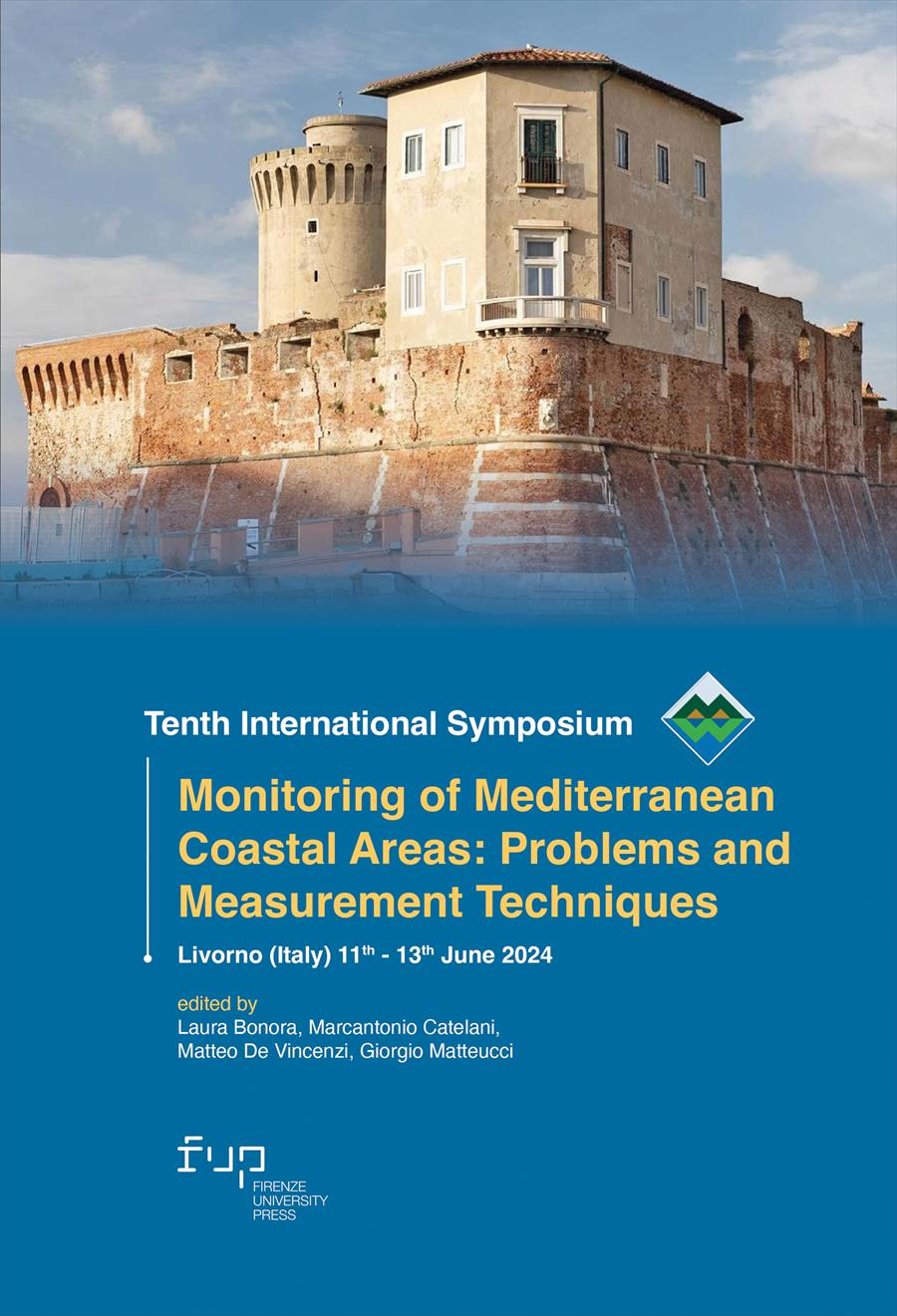- Tenth International Symposium "Monitoring of Mediterranean Coastal Areas: Problems and Measurement Techniques"
- Edited by Laura Bonora, Marcantonio Catelani, Matteo De Vincenzi, Giorgio Matteucci
Coastal Landscape and “Disappearing” Territories
- Antonietta Ivona
- Donatella Privitera
- © 2024 Author(s) |
- CC BY-NC-SA 4.0
- DOI: 10.36253/979-12-215-0556-6.36
The relationship between climate and tourism is very close, and this connection is even more evident for tourism in coastal areas. The various impacts of climate change have long been obvious in many destinations. In addition, like all sectors, also tourism contributes to the production and emission of greenhouse gases, with devastating consequences for certain areas. Through a case study, this contribution aims to reflect on territories that are disappearing due to climate change combined with excessive tourism. A new form of tourism, known as last chance tourism, has emerged as a result. In recent decades, warming in the Mediterranean has been much faster than in the rest of the world, causing serious territorial and economic consequences. Entire areas traditionally dedicated to tourism today have to deal with a drastic decrease in the number of tourists or, in some cases, an excessive increase in them to visit places with an uncertain future..
- Keywords:
- Last chance tourism,
- case study,
- global warming,
- coastal erosion,
University of Bari Aldo Moro, Italy - ORCID: 0000-0003-3508-4489
University of Catania, Italy - ORCID: 0000-0002-1290-5451
- Ambiente e non solo (2024) - I dati sull’erosione della costa italiana, https://ambientenonsolo.com.
- Denley T. J., Woosnam, K. M., Ribeiro M. A., Boley B. B., Hehir C., Abrams J. (2020) - Individuals’ intentions to engage in last chance tourism: Applying the value-belief-norm model. J. Sustain. Tour., 28(11), 1860-1881. DOI: 10.1080/09669582.2020.1762623
- D’Souza J., Dawson J., Groulx M. (2021) - Last chance tourism: a decade review of a case study on Churchill, Manitoba’s polar bear viewing industry. J. Sustain. Tour., 31(1), 14-31. DOI: 10.1080/09669582.2021.1910828
- European Travel Commission - ETC (2023), - Monitoring Sentiment for Domestic and Intra-European Travel, https://etc-corporate.org
- Fisher D., Stewart E. J. (2017) - Tourism, Time, and the Last Chance. Tour. Anal., 22(4), 511-521. DOI: 10.3727/108354217X15023805452068
- Hall C. M., Wood K. (2021) - Demarketing tourism for sustainability: Degrowing tourism or moving the deckchairs on the Titanic? Sustainability, 13, 1585. DOI: 10.3390/su13031585
- Hehir C., Scarles C., Wyles K.J., Kantenbacher J. (2023) - Last chance for wildlife: making tourism count for conservation. J. Sustain. Tour., 31, 5, 1271-1291. DOI: 10.1080/09669582.2022.2049804
- Hoogendoorn G. (2021) - Last Chance Tourism in South Africa: Future Research Potential? Tourism: An International Interdisciplinary Journal, 69(1), 73-82. DOI: 10.37741/t.69.1.6
- ISPRA (2021) - Rapporto ISPRA sul Dissesto Idrogeologico in Italia - Ed. 2021, https://www.isprambiente.gov.it.
- ISPRA (2023) - Cambiamenti climatici ed erosione costiera. https://sinacloud. isprambiente.it/portal/apps/sites/coste.
- Lee H., Romero J. (eds) (2023) - Sections. In: Climate Change 2023: Synthesis Report. Contribution of Working Groups I, II and III to the Sixth Assessment Report of the Intergovernmental Panel on Climate Change. IPCC, Geneva, Switzerland, 35-115. DOI: 10.59327/IPCC/AR6-9789291691647
- Legambiente (2021), Rapporto Spiagge 2021, https://www.legambiente.it.
- Legambiente (2023) - Rapporto Spiagge 2023, https://www.legambiente.it.
- Legambiente (2024) - Rapporto Spiagge 2024, https://www.legambiente.it
- Lemelin R. H., Dawson J., Stewart E.J., Maher P., Lück M. (2010) - Last-chance tourism: The boom, doom, and gloom of visiting vanishing destinations. Curr. Issues Tour., 13(5), 477-493. DOI: 10.1080/13683500903406367
- Miller L. B., Hallo J. C., Dvorak R. G., Fefer J. P., Peterson B. A., Brownlee M. T. J. (2020) - On the edge of the world: examining pro-environmental outcomes of last chance tourism in Kaktovik, Alaska, J. Sustain. Tour., 28(11), 1703-1722. DOI: 10.1080/09669582.2020.1720696
- Pforr C. (2024) - Last Chance to Behave Badly at Uluṟu, Australia. A Critical Reflection on the Interplay of Overtourism and Last Chance Tourism. Pechlaner H., Innerhofer E., Philipp J., (eds) From Overtourism to Sustainability Governance. A New Tourism Era, Routledge, New York. DOI: 10.4324/9781003365815-19
- Stewart E.J., Wilson J., Espiner S., Purdie H., Lemieux C., Dawson J. (2016) - Implications of climate change for glacier tourism. Tourism Geogr., 18(4), 377-398. DOI: 10.1080/14616688.2016.1198416
- Tombleson B., Wolf K. (2022) - Sustainable tourism and public opinion: Examining the language surrounding the closure of Uluru to climbers, Sigala M., Yeark A., Presbury R., Fang M., Smith K.A. (eds.), Case based research in tourism, travel, hospitality and events, Springer, Singapore. DOI: 10.1007/978-981-16-4671-3_22
- Zanchini E., Manigrasso M. (2017) - VISTA MARE. La trasformazione dei paesaggi costieri italiani, Edizioni Ambiente, Milano.
Chapter Information
Chapter Title
Coastal Landscape and “Disappearing” Territories
Authors
Antonietta Ivona, Donatella Privitera
Language
English
DOI
10.36253/979-12-215-0556-6.36
Peer Reviewed
Publication Year
2024
Copyright Information
© 2024 Author(s)
Content License
Metadata License
Bibliographic Information
Book Title
Tenth International Symposium "Monitoring of Mediterranean Coastal Areas: Problems and Measurement Techniques"
Book Subtitle
Livorno (Italy) 11th-13th June 2024
Editors
Laura Bonora, Marcantonio Catelani, Matteo De Vincenzi, Giorgio Matteucci
Peer Reviewed
Publication Year
2024
Copyright Information
© 2024 Author(s)
Content License
Metadata License
Publisher Name
Firenze University Press
DOI
10.36253/979-12-215-0556-6
eISBN (pdf)
979-12-215-0556-6
eISBN (xml)
979-12-215-0557-3
Series Title
Monitoring of Mediterranean Coastal Areas: Problems and Measurement Techniques
Series E-ISSN
2975-0288
